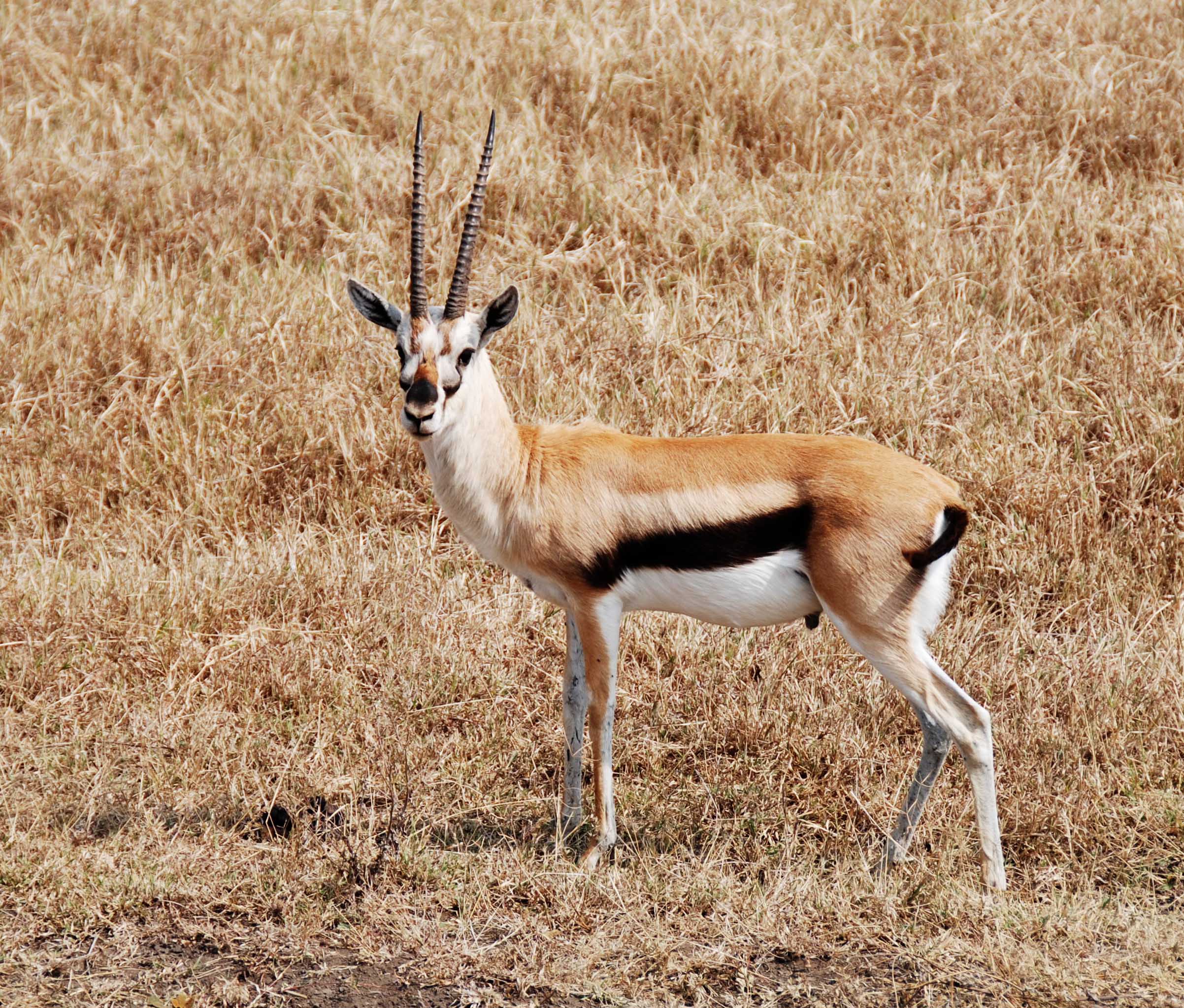- Thomson's Gazelle
Taxobox
name = Thomson's Gazelle
status = lr/cd
status_system = iucn2.3
image_caption = Male Thomson's gazelle. Ngorongoro Crater, Tanzania.
regnum =Animal ia
phylum = Chordata
classis =Mammal ia
ordo =Artiodactyla
familia =Bovidae
subfamilia =Antilopinae
genus = "Eudorcas "
species = "E. thomsoni"
binomial = "Eudorcas thomsoni"
binomial_authority = Günther, 1884The Thomson's gazelle ("Eudorcas thomsoni") is one of the best-knowngazelle s. It is named after explorer Joseph Thomson, and is often referred to as the "tommy". It is considered by some (e.g. Kingdon 1997) to be a subspecies of theRed-fronted Gazelle ("E. rufifrons"). It was formerly considered a member of the genus "Gazella" within the subgenus "Eudorcas" before "Eudorcas" was elevated to genus status.Description
Thomson's gazelles are 60–90 cm (24-35 in) tall and weigh 13–22 kg (29-40 lb). They have light brown coats with white underparts and a distinctive black stripe. Their horns are long and pointed with slight curvature. The white patch on their rump extends to underneath the tail but no further. A mistake sometimes made is the misidentification of
Grant's Gazelle s as Thomson's Gazelles. Although some Grant's do have the black stripe running across their sides, the white on their rump always extends above the tail.Ecology and distribution
Thomson's gazelles live in Africa's savannas and grassland habitats, particularly the
Serengeti region ofKenya andTanzania , though they can also be found inEthiopia ,Somalia , andSudan . They eat low vegetation and grass. Most of the water they need comes from what they eat. Though it's one of the most common gazelles in its range, the population size is not large due to its limited range. The gazelle is a favored prey item for thecheetah .ocial structure and behaviour
Thomson's gazelles often congregate with other hoofed mammals, or
ungulate s, such aswildebeest andzebra and usually live and migrate in herds with hundreds or thousands of other gazelles. The social structure of gazelles consists of several types of groups. Male gazelles are territorial throughout their adult lives, though not usually before 2-3 years of age. During the non-territorial periods males usually spend their time in bachelor groups or as part of a mixed herd. Likewise females will form migratory female groups that travel through the males' territory. As the female groups pass through, the territorial males will try to herd them to prevent them from leaving. Adult male bucks with adjoining territories will engage in combat several times a day, fighting with their horns to establish dominance and the boundaries of their territories. In this way, the accepted boundaries of the territory can change on a daily basis. If a lone male, a bachelor group, or in some cases even an adolescent male fawn of a female gazelle should be passing through a territorial male's region, the male will chase the offender out of his territory. Interestingly, this territoriality does not extend to males of other species. The territory of a Thomson's gazelle and several other types of ungulates may overlap with no problem whatsoever. Occasionally, a Thomson's gazelle and a zebra or other ungulate will even appear to enjoy one another's company with great sociability. A noticeable behaviour of Thomson's gazelles is their bounding leap, known asstotting or pronking, used to startle predators and display strength.Breeding and life expectancy
Female Thomson's gazelles give birth to single fawns after a 5–6 month gestation period. They are unusual among ungulates in that they can give birth twice yearly, rather than just once.
In the wild, Thomson's gazelles can live up to 10–15 years, although they are preyed on by most African big cats, hyenas and baboons. Cheetahs are able to attain higher speeds, but Thomson's Gazelles can outlast cheetahs in long chases and are able to make turns more speedily. Half of all the fawns born will be lost to predators before reaching adulthood.Fact|date=February 2007
References
* Kingdon, Jonathan (1997) "The Kingdon Field Guide to African Mammals". Academic Press, San Diego and London. Pp. 411–413. (ISBN 0-12-408355-2)
* Antelope Specialist Group 1996. [http://www.iucnredlist.org/search/details.php/8982/all Gazella thomsonii] . [http://www.iucnredlist.org 2006 IUCN Red List of Threatened Species. ] Downloaded on30 July 2007 .
Wikimedia Foundation. 2010.
